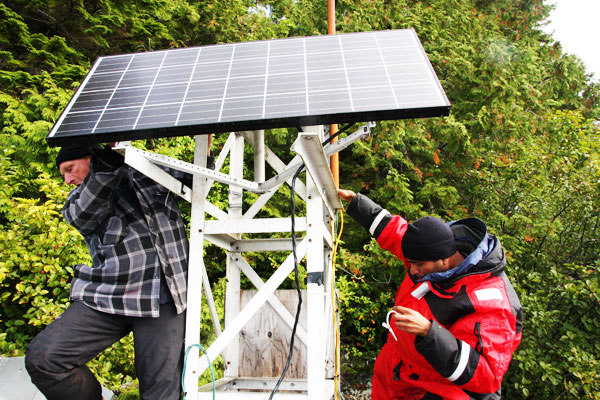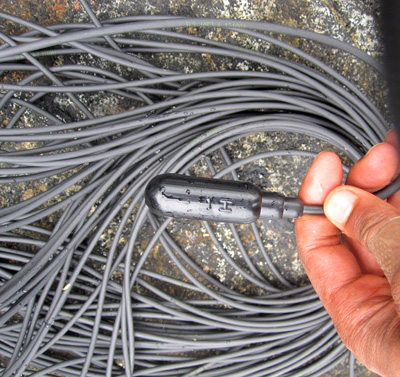Finding Yoda – Part 3
In a blog series this month from the Pacific Coast, whale researcher Janie Wray follows the story of Yoda, a charismatic humpback whale who literally makes waves wherever he goes. So far we’ve followed Yoda’s arrival to the rich summer feeding grounds of B.C.’s north coast. Today we find Yoda in the company of humpbacks that sing their mysterious songs in these quiet ocean waters. WWF is working here with Cetacea Lab on an exciting new hydrophone project – the first of its kind in Canada – to understand how noise from the increased shipping traffic in B.C. waters could affect this quiet habitat for whales.
Written by Janie Wray, Director of Cetacea Lab
It’s late August and I’m just finishing a whale survey in Squally Channel. Suddenly, I see a whale blow close to one of our hydrophones that is stationed 80 feet below water in the intertidal zone. It’s been an extremely long day on the water, I’m exhausted, but something pushes me to identify this one last whale. I’m soon happy I did. Calling my research partner Hermann by marine radio, I only need to ask once, “Guess who I just saw?”
“Yoda, of course,” Hermann replies.
The last week of every August, we expect the arrival of this energetic humpback whale in Caamano Sound. And once again, Yoda is right on schedule. As the days become shorter, the humpbacks transition to feeding in smaller groups and the males begin to compete for females. This is when we know Yoda will arrive.
Back at the lab, I’m taking off my survival suit when I hear a sound that, to this day, melts my soul. On the same date as Yoda’s arrival, the first humpback song of the year has begun. At first I‘m so overwhelmed by the beauty of this song, I almost forget to press record. I can already tell this song – carried collectively by all the males – is different from the one sung last year. These calls are long with a gentle, hollow ending that echoes through the underwater canyons of Squally Channel.
The humpback’s song plays a huge role during the breeding season. Only the males sing, and even though we still don’t fully understand its purpose, we know their song is a crucial component of their culture; it’s believed to be essential to finding a mate.
It’s one thing to observe whales on the water but the ability to listen to them at the same time truly completes the picture. Whales depend on sound much the same way we depend on sight. They’ve evolved in an underwater environment where there is very little light – taking advantage of the ability water has to transmit sounds extremely far and fast. Humpback whales, like many marine animals, depend on sound to find food, look for mates, navigate and engage in social behaviours such as singing.
When we first arrived on Gil Island to study whales, we installed a network of underwater hydrophones from Caamano Sound to Douglas Channel. Now with the support of WWF, we’re working on an exciting new hydrophone network that will take us a step closer to understanding this acoustic world of whales. By triangulating the position of these digital underwater “smart phones”, we’ll receive data that will allow us eventually to pinpoint the exact location of a vocalizing whale.

Over time, we’ll be able to locate whale “hot spots” to determine where humpbacks gather to sing and feed. Looking ahead, I won’t be surprised to find out that, from season to season, these “hotspots” will be the same year after year. This gives us a better understanding of which areas are critical for habitat use and should be protected as low traffic quiet zone for whales.
This project will also help us understand how underwater noise from human activity – such as shipping – affects whales. Today these waters are among the quietest on B.C.’s coast; one of the majors reasons, I believe, humpback singing has increased here. When Hermann and I first set up Cetacea Lab in 2002, we recorded 40 to 50 hours per season of humpback whales singing. Now that number has reached well over 500 hundred hours of glorious song each year!

Today, as I listen to the song arising from the depths of Squally Channel, it’s like going back in time. The only sound I hear in this quiet ocean is the masterpiece of song a humpback is creating.
Unfortunately, this may all change in the near future. Just as we’ve witnessed the remarkable return of humpback whales after near extinction from hunting, a new threat has come to the waters they call home. Massive tankers are proposed to transport oil and gas through these waters, bringing the threat of increased noise, ship strikes and spills. So today, as I sit and listen to this whale I imagine to be Yoda, I’m grateful for this soulful performance, yet saddened this magical place may not remain in the future as it is today.
Learn more about Cetacea Lab’s work.
Learn more about WWF’s work on B.C.’s north coast.
Help protect the Great Bear Sea for now, and forever. Visit Greatbearsea.org and add your name.
